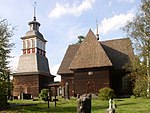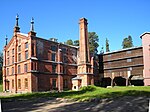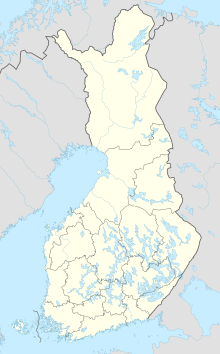List of World Heritage Sites in Finland
TheUnited Nations Educational, Scientific and Cultural Organization(UNESCO)World Heritage Sitesare places of importance toculturalornatural heritageas described in the UNESCO World Heritage Convention, established in 1972.[1]Finlandaccepted the convention on 4 March 1987, making its historical sites eligible for inclusion on the list. The first two sites added to the list wereOld Raumaand theFortress of Suomenlinna,both in 1991, at the 15th Session of theWorld Heritage Committee,held inCarthage,Tunisia.[2]Further sites were added in 1994, 1996, 1999, 2005, and 2006.[3]
There are seven World Heritage Sites inFinland,[3][4]six of which are classified as cultural sites according to the UNESCO criteria, and one natural site, theHigh Coast/Kvarken Archipelago.This is a transnational site and is shared with Sweden. The Swedish part, the High Coast, was listed individually in 2000; the Kvarken Archipelago was added in 2006. There is another transnational site in Finland, theStruve Geodetic Arc,a cultural site listed in 2005, which is shared with nine other countries.[3]In addition to its World Heritage Sites, Finland also maintains three properties on its tentative list.[3]
World Heritage Sites
[edit]UNESCO lists sites underten criteria;each entry must meet at least one of the criteria. Criteria i through vi are cultural, and vii through x are natural.[5]
| Site | Image | Location | Year listed | UNESCO data | Description |
|---|---|---|---|---|---|
| Old Rauma | 
|
Rauma | 1991 | 582; iv, v (cultural) |
Old Rauma is the medieval central part of the town of Rauma at theGulf of Bothnia.It consists of around 600 wooden houses which are now used both for residential and commercial purposes. TheChurch of the Holy Crossdates to the 16th century while the rest of the urban area has been rebuilt after fires and dates to the 17th to 19th centuries. Minor boundary modifications took place in 2009.[6][7] |
| Fortress of Suomenlinna | 
|
Helsinki | 1991 | 583; iv (cultural) |
The fortress, which is built on six islands at the entrance to the port ofHelsinki,was built by Sweden in the 18th century to defend against theRussian Empire.There are 200 buildings and the defensive walls stretch over 6 kilometres (3.7 mi). AfterWorld War II,the military role of the fortress declined. It was repurposed for public use and is now a popular tourist destination.[8] |
| Petäjävesi Old Church | 
|
Petäjävesi,Central Finland | 1994 | 584; iv (cultural) |
This church is a typical example of the architectural tradition of wooden churches in northern Europe. It was built between 1763 and 1765 and demonstrates the masterful application of European architectural influences to a structure made of logs. The centrally planned church shows Renaissance influences while the steep roof recalls the Gothic tradition. The bell tower was added in 1821. The church is well preserved due to the fact that it was abandoned in the late 19th century, as the new parish church was built, and did not suffer from major alterations such as the installation of heating systems. It was carefully restored after 1920. The church still holds services regularly in summer.[9] |
| Verla Groundwood and Board Mill | 
|
Kouvola(Jaala),Kymenlaakso | 1996 | 751; iv (cultural) |
The mill and the surrounding residential area represent a type of small-scale rural industrial settlement common in the 19th and early 20th centuries, associated withpulp,paper, and board production. These types of settlements flourished in northern Europe and North America, where the raw materials were abundant. The Verla Mill operated until 1964, after which it was converted into a museum.[10] |
| Bronze Age Burial Site of Sammallahdenmäki | 
|
Rauma | 1999 | 579; iii, iv (cultural) |
This burial site dates back to theBronze Ageand the earlyIron Age,from 1500 to 500 BCE. The site includes 33 burialcairnsin several clusters. The cairns are connected tosun worship,a religion that spread to Finland from Scandinavia. Originally, they were built near the coast but are now further inland due to the rising land.[11] |
| Struve Geodetic Arc* | Enontekiö,Ylitornio,Tornio,Korpilahti,Lapinjärvi,Pyhtää | 2005 | 1187, ii, iii, vi (cultural) |
The Struve Geodetic Arc is a series oftriangulationpoints, stretching over a distance of 2,820 kilometres (1,750 mi) fromHammerfestin Norway to theBlack Sea.The points were set up in a survey by the astronomerFriedrich Georg Wilhelm Struvewho first carried out an accurate measurement of a long segment of a meridian, which helped to establish the size and shape of the Earth. Originally, there were 265 station points. The World Heritage Site includes 34 points in ten countries (north to south: Norway, Sweden, Finland, Russia, Estonia, Latvia, Lithuania, Belarus, Moldova, Ukraine), six of which are in Finland.AlatornioChurch, one of the station points in Finland, is pictured.[12] | |
| High Coast/Kvarken Archipelago* | 
|
Kvarken | 2006 | 898bis; viii (natural) |
This is an extension of the High Coast site in Sweden, originally listed in 2000. Both the High Coast and the Kvarken Archipelago are situated in the Gulf of Bothnia and include thousands of islands. The area shows prominent effects of thepost-glacial rebound,the rising of the land following the melting of the continentalice sheetafter theLast Glacial Maximum(thus removing the weight of the glaciers), 10,000 to 24,000 years ago. The rising, in some places up to almost 300 metres (980 ft), is constantly changing the landscape.[13] |
Tentative list
[edit]In addition to sites inscribed on the World Heritage List, member states can maintain a list of tentative sites that they may consider for nomination. Nominations for the World Heritage List are only accepted if the site was previously listed on the tentative list.[14]As of 2021, Finland lists two properties on its tentative list.[3]
| Site | Image | Location | Year listed | UNESCO criteria | Description |
|---|---|---|---|---|---|
| The Architectural Works of Alvar Aalto - a Human Dimension to the Modern Movement | 
|
Paimio,Helsinki,Kotka,Pori,Säynätsalo,Muuratsalo,Imatra,Jyväskylä,Seinäjoki | 2021 | ii (cultural) | This nomination comprises works by prominent FinnishModernistarchitectAlvar Aalto:thePaimio Sanatorium,Aalto House, the Sunila Pulp Mill Housing Area, Villa Mairea,SäynätsaloTown Hall, the Experimental House, Muuratsalo, Studio Aalto, the Church of Three Crosses, Vuoksenniska, the House of Culture, theUniversity of Jyväskylä,Aalto Campus, the Social Insurance Institution Main Office, theSeinäjokiCivic Centre, andFinlandia Hall[15] |
| TheRinged SealArchipelagos ofLake Saimaa* | 
|
Ristiina | 2021 | ix, x (natural) | Lake Saimaa, located in south-eastern Finland, the largest lake in Finland at 4,400 square kilometres (1,700 sq mi), is the only habitat of theSaimaa ringed seal(Phoca hispida saimensis). This seal subspecies has become landlocked and has adapted to the freshwated environment following theend of the last glaciation.[16] |
See also
[edit]References
[edit]- ^"The World Heritage Convention".UNESCO World Heritage Centre.Archivedfrom the original on 27 August 2016.Retrieved21 September2010.
- ^"15th session of the World Heritage Committee".UNESCO World Heritage Centre.Archivedfrom the original on 20 November 2019.Retrieved19 January2020.
- ^abcde"Finland".UNESCO World Heritage Centre.Archivedfrom the original on 22 November 2019.Retrieved24 November2019.
- ^"Treasure trove: Finnish Unesco sites - thisisFINLAND".Finland.fi. 9 January 2015.Archivedfrom the original on 6 April 2019.Retrieved24 November2019.
- ^"UNESCO World Heritage Centre – The Criteria for Selection".UNESCO World Heritage Centre.Archivedfrom the original on 12 June 2016.Retrieved17 August2018.
- ^"Old Rauma".UNESCO World Heritage Centre.Archivedfrom the original on 17 October 2011.Retrieved20 October2011.
- ^"Old Rauma"(PDF).UNESCO World Heritage Centre. p. 52.Archived(PDF)from the original on 12 September 2014.Retrieved20 October2011.
- ^"Fortress of Suomenlinna".UNESCO World Heritage Centre.Archivedfrom the original on 17 October 2011.Retrieved20 October2011.
- ^"Petäjävesi Old Church".UNESCO World Heritage Centre.Archivedfrom the original on 17 October 2011.Retrieved20 October2011.
- ^"Verla Groundwood and Board Mill".UNESCO World Heritage Centre.Archivedfrom the original on 17 October 2011.Retrieved20 October2011.
- ^"Bronze Age Burial Site of Sammallahdenmäki".UNESCO World Heritage Centre.Archivedfrom the original on 18 October 2011.Retrieved20 October2011.
- ^"Struve Geodetic Arc".UNESCO World Heritage Centre.Archivedfrom the original on 18 October 2011.Retrieved20 October2011.
- ^"High Coast / Kvarken Archipelago".UNESCO World Heritage Centre.Archivedfrom the original on 17 October 2011.Retrieved20 October2011.
- ^"Tentative Lists".UNESCO World Heritage Centre.Archivedfrom the original on 17 October 2010.Retrieved7 October2010.
- ^"The Architectural Works of Alvar Aalto - a Human Dimension to the Modern Movement".UNESCO World Heritage Centre.Archivedfrom the original on 27 March 2021.Retrieved16 March2021.
- ^"The Ringed Seal Archipelagos of Lake Saimaa".UNESCO World Heritage Centre.Archivedfrom the original on 20 March 2021.Retrieved16 March2021.



